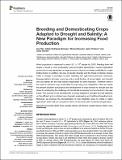Por favor, use este identificador para citar o enlazar a este item:
http://hdl.handle.net/10261/152908COMPARTIR / EXPORTAR:
 SHARE SHARE
 CORE
BASE CORE
BASE
|
|
| Visualizar otros formatos: MARC | Dublin Core | RDF | ORE | MODS | METS | DIDL | DATACITE | |

| Campo DC | Valor | Lengua/Idioma |
|---|---|---|
| dc.contributor.author | Fita, Ana | - |
| dc.contributor.author | Rodríguez-Burruezo, Adrián | - |
| dc.contributor.author | Boscaiu, Mónica | - |
| dc.contributor.author | Prohens, Jaime | - |
| dc.contributor.author | Vicente, Óscar | - |
| dc.date.accessioned | 2017-07-14T11:22:30Z | - |
| dc.date.available | 2017-07-14T11:22:30Z | - |
| dc.date.issued | 2015-11-12 | - |
| dc.identifier.citation | Frontiers in Plant Science 6: 978 (2015) | - |
| dc.identifier.issn | 1664-462X | - |
| dc.identifier.uri | http://hdl.handle.net/10261/152908 | - |
| dc.description.abstract | World population is expected to reach 9.2 × 109 people by 2050. Feeding them will require a boost in crop productivity using innovative approaches. Current agricultural production is very dependent on large amounts of inputs and water availability is a major limiting factor. In addition, the loss of genetic diversity and the threat of climate change make a change of paradigm in plant breeding and agricultural practices necessary. Average yields in all major crops are only a small fraction of record yields, and drought and soil salinity are the main factors responsible for yield reduction. Therefore there is the need to enhance crop productivity by improving crop adaptation. Here we review the present situation and propose the development of crops tolerant to drought and salt stress for addressing the challenge of dramatically increasing food production in the near future. The success in the development of crops adapted to drought and salt depends on the efficient and combined use of genetic engineering and traditional breeding tools. Moreover, we propose the domestication of new halophilic crops to create a ‘saline agriculture’ which will not compete in terms of resources with conventional agriculture. | - |
| dc.publisher | Frontiers Media | - |
| dc.relation.isversionof | Publisher's version | - |
| dc.rights | openAccess | - |
| dc.title | Breeding and Domesticating Crops Adapted to Drought and Salinity: A New Paradigm for Increasing Food Production | - |
| dc.type | artículo | - |
| dc.identifier.doi | 10.3389/fpls.2015.00978 | - |
| dc.description.peerreviewed | Peer reviewed | - |
| dc.relation.publisherversion | http://dx.doi.org/10.3389/fpls.2015.00978 | - |
| dc.date.updated | 2017-07-14T11:22:30Z | - |
| dc.description.version | Peer Reviewed | - |
| dc.language.rfc3066 | en | - |
| dc.rights.holder | Copyright © 2015 Fita, Rodríguez-Burruezo, Boscaiu, Prohens and Vicente. | - |
| dc.rights.license | http://creativecommons.org/licenses/by/4.0/ | - |
| dc.relation.csic | Sí | - |
| dc.identifier.pmid | 26617620 | - |
| dc.type.coar | http://purl.org/coar/resource_type/c_6501 | es_ES |
| item.fulltext | With Fulltext | - |
| item.openairecristype | http://purl.org/coar/resource_type/c_18cf | - |
| item.cerifentitytype | Publications | - |
| item.grantfulltext | open | - |
| item.openairetype | artículo | - |
| Aparece en las colecciones: | (IBMCP) Artículos | |
Ficheros en este ítem:
| Fichero | Descripción | Tamaño | Formato | |
|---|---|---|---|---|
| Breeding and Domesticating Crops Adapted.pdf | 3,87 MB | Adobe PDF |  Visualizar/Abrir |
CORE Recommender
PubMed Central
Citations
74
checked on 18-mar-2024
SCOPUSTM
Citations
264
checked on 23-abr-2024
WEB OF SCIENCETM
Citations
221
checked on 24-feb-2024
Page view(s)
268
checked on 23-abr-2024
Download(s)
311
checked on 23-abr-2024

